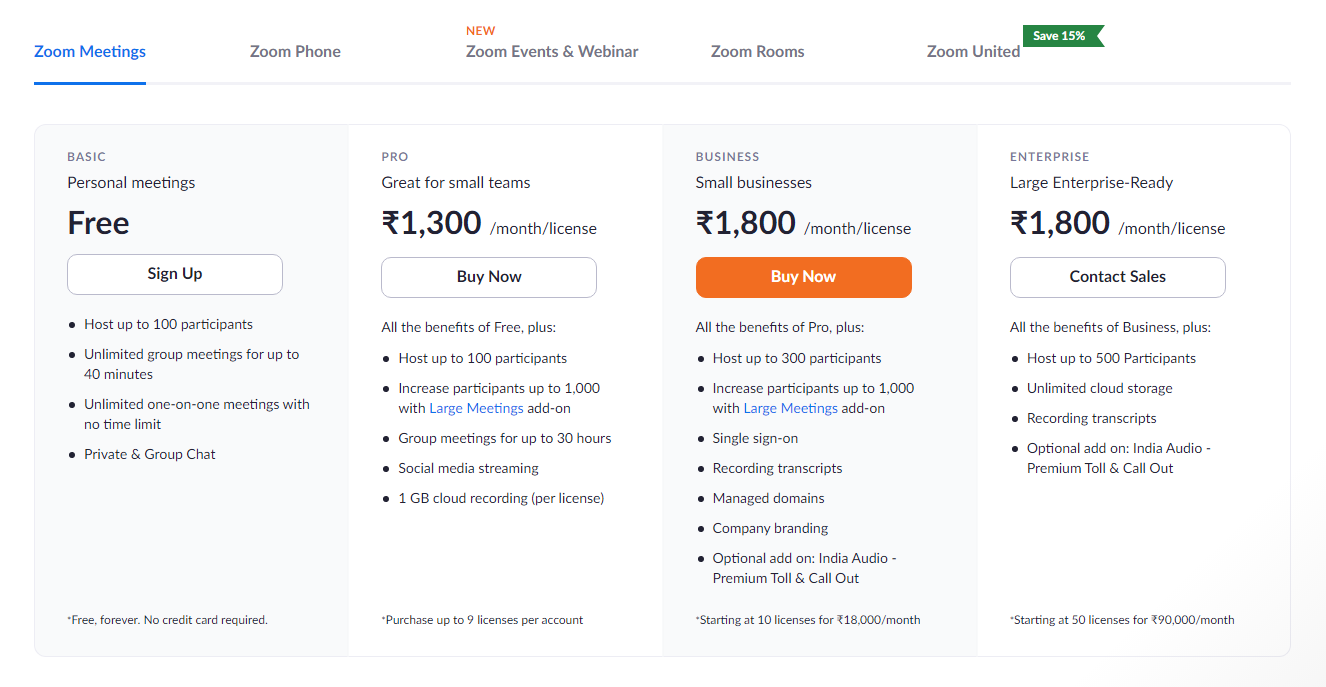The Zoom pricing section is effective for several reasons:
- Clear Hierarchy and Visual Appeal:
- Tabbed Navigation: The tabs at the top (Zoom Meetings, Zoom Phone, etc.) allow users to easily navigate to different product offerings.
- Tiered Structure: Four distinct tiers (BASIC, PRO, BUSINESS, ENTERPRISE) are clearly displayed with visual separation.
- Pricing Clarity: Prices are prominently displayed for each tier, with clear unit costs (
₹1,300/month/license, etc.). The BASIC tier is clearly marked “Free.”
- Call to Action: “Sign Up,” “Buy Now,” and “Contact Sales” buttons are clearly visible and encourage user engagement.
- Visual Cues: The orange “Buy Now” button for the BUSINESS tier draws attention to it, suggesting it might be a popular or recommended option. The “Save 15%” badge highlights potential savings.
- Layout: The layout is clean, organized, and easy to scan.
- Value-Based Differentiation:
- Target Audience: Each tier description highlights the target user and their needs, progressing from personal meetings to large enterprise-ready solutions.
- Feature Progression: The descriptions and feature lists clearly show the increasing functionality and complexity of each tier.
- Key Differentiators: Participant limits, meeting duration, cloud recording, and advanced features like single sign-on and managed domains are used as key differentiators.
- Focus on Benefits: The messaging focuses on the benefits users will receive, such as increased participant capacity, longer meeting durations, and advanced management features.
- Add-on Options: The optional add-ons (Large Meetings, India Audio) provide flexibility and cater to specific needs.
- Transparent Pricing:
- Clear Pricing: Prices are clearly displayed for each tier, including the free option.
- License Limits: The purchase limits for PRO and the starting license counts for BUSINESS and ENTERPRISE are clearly stated.
- Free Tier: The BASIC tier is clearly marked “Free, forever. No credit card required,” making it an attractive option for users to try the service.
- Addressing Different User Needs:
- Tier Names: The names suggest different levels of service and functionality.
- Target Audience Descriptions: The descriptions explicitly target different customer segments based on their needs and business size.
- Feature Set: The features offered in each tier cater to different needs and budgets.
- Strategic Use of Information:
- Call to Action: The prominent CTAs drive conversions.
- Concise Messaging: The descriptions and feature lists are brief and to the point.
- Visual Clarity: The use of bullet points makes it easy to compare features across tiers.
- Free Tier: The Free tier lowers the barrier to entry and encourages users to try the service.
- Orange Button: The orange “Buy Now” button for the BUSINESS tier draws attention to it, potentially increasing conversions for that tier.



